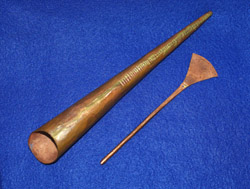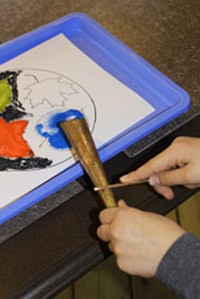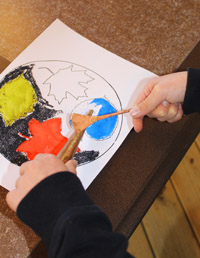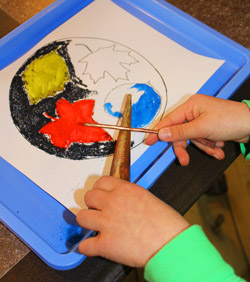
Every once in a while, I like to share some of our interfaith mistakes. Despite our best efforts to educate ourselves, learning about other faith traditions is a process, and it doesn’t always go perfectly. Fortunately, we have interfaith friends who happily set us straight, and we usually manage to amuse rather than offend.
This particular mistake involved a chakpur {CHOK-per} – the tool used to make Tibetan sand mandalas. Here in the Jubilee! Church Nurture Program, we have made our own kid-friendly versions of sand mandalas on many occasions. It’s a great craft, even for our youngest kids, and there are several recipes on line for DIY colored sand. We give the kids a simple pattern and let them spread liquid glue on a section of the image. Then, they apply the colored sand with their fingers.
Of course, you would never see Buddhist priests making sand mandalas in this manner! Because mandalas are dispersed upon completion, the formal process involves no glue. Moreover, because the traditional images are highly detailed, the sand is applied using a tool called a chakpur which consists of a metal funnel and a brush-like instrument. When the brush-like piece is rubbed along the ridges of the funnel, the vibrations cause a few grains of sand to fall into place. I thought it would be fun for the kids to use a chakpur, so we bought one. It cost about $25 from a Buddhist supply store, and we let the kids pass it around and try it – just to see how it works and what it feels like.
We certainly enjoyed our oblivion while it lasted. A few weeks ago, I was writing an article for The Interfaith Observer. The theme was “The Arts,” and I was putting together a piece highlighting a few of our crafts from various faith traditions. I included a couple of paragraphs on our autumn equinox sand mandalas. The image consists of a few leaves arranged in a circle, but as I searched through our photos, I realized we didn’t have any pictures of the kids using the chakpur. It seemed important to include one, so I staged a photo using my son. Here it is.

A few days later, I happened to be Facebook messaging with my friend and colleague, Hun Lye, founder of Urban Dharma in Asheville. I was telling him about the photo. For fun, I attached it. He immediately messaged back, “It’s backwards!”
Crap. At some point, I had subconsciously wondered about how the funnel was supposed to be held, but I had never actually checked on it. I hadn’t even paid much attention to what the kids were doing. They seemed to be having fun, they learned a new word, and we all felt exceedingly proud of our interfaith efforts. In fact, because I am the curriculum develop and administrator, I am rarely even in the classroom when they are playing with it.
That evening, I told my son we needed to take the photo again because he was holding the chakpur incorrectly. Even though I was using only his hands in the picture, he wasn’t all that happy to help out. I offered to pay him $2, so he agreed. We turned the funnel around and took another photo. Here it is.

Just for fun, I messaged Hun Lye on Facebook the next day and told him that I had been forced to pay my son for a re-shoot. I attached the photo, quite pleased with myself. His response? “It’s still wrong!”
What?! How was that possible? There are only two pieces to a chakpur. How many different ways could one hold them?!
“The fan portion is used to straighten the lines. It’s the small end of the stick that is rubbed along the funnel,” Hun Lye wrote.
Unbelievable. We don’t even straighten our lines! It was looking like I was going to be out another $2, and I still didn’t have my photo! That evening, I went home and told my son we needed to take yet another picture. He must have felt sorry for me at this point because he agreed to do it without charging any additional money. Here’s the final – and completely correct – photo.

As with most of our mistakes, this one was about not paying enough attention. The problem is that we don’t always know what we’re supposed to pay attention to. If the question of how, exactly, the chakpur should be held had ever entered my mind, I would have looked it up on the internet. There are plenty of images and You Tube videos showing the construction of sand mandalas. It simply never occurred to me to check.
And, like all of our previous mistakes, everyone survived. I was a little embarrassed, and my son was mildly irritated, but these are small consequences when compared to the enormous benefits we see when doing interfaith education for kids. On top of that, even the grown-ups learned something this time around!